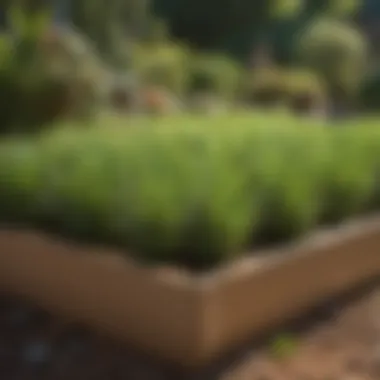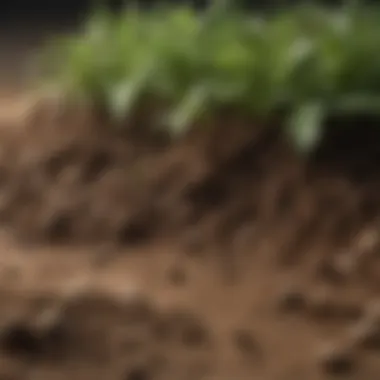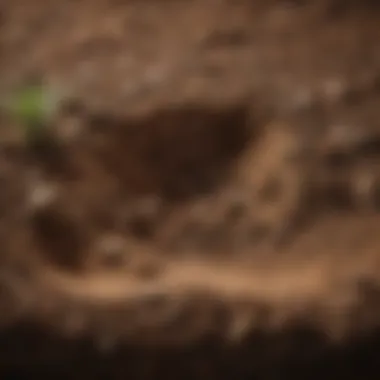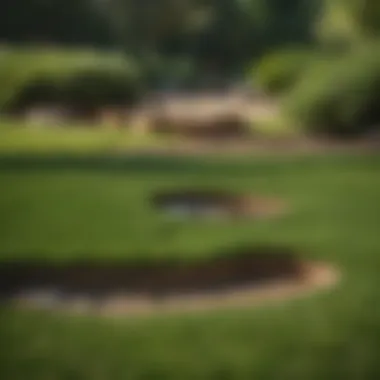Mastering Cardboard for Grass Control and Soil Health


Intro
The use of cardboard as a method to eliminate unwanted grass is gaining traction among gardening enthusiasts. This practical approach not only addresses the issue of invasive grass but also contributes positively to soil health. Key to understanding its efficacy lies in the biodegradable nature of cardboard, which serves as a natural barrier while enhancing the microbial ecosystem in the soil.
In this article, we will explore the mechanics behind how cardboard suppresses grass growth. We will also discuss practical steps for implementation in home gardens, enabling both novice and experienced gardeners to employ this technique effectively. The broader implications of using cardboard for landscaping and sustainable gardening practices will also be examined. Key insights into how this method can promote a healthier environment for plant growth will provide a well-rounded perspective on its role in eco-friendly gardening.
By understanding the simplicity and effectiveness of this method, homeowners and gardening aficionados can harness the potential of cardboard, transforming unwanted grassy areas into thriving garden spaces. Let's delve deeper into the fundamentals of this innovative technique.
Understanding the Need for Grass Control
Managing grass in a garden is crucial for many reasons. First, unwanted grass can compete with desired plants for resources like water and nutrients. When grass grows uncontrollably, it can lead to stunted growth of vegetables, flowers, or ornamental plants. This affects the overall health of a garden, making it less productive and aesthetically pleasing.
Another significant reason for controlling grass is maintenance. Unmanaged grass often requires frequent mowing, which can be laborious and time-consuming. Homeowners may find this task daunting, especially if grass becomes overgrown. Therefore, managing grass early on can result in a more efficient use of time and effort in maintaining the garden.
Additionally, unwanted grass can attract pests and diseases. Some grass species can host insects that may harm other plants. This can lead to a cycle where gardens become targets for more problems, disrupting the balance of a healthy ecosystem.
"Effective grass control leads to a thriving garden environment, improving both plant health and maintenance ease."
Finally, as sustainable gardening practices gain traction, it's becoming increasingly important to utilize eco-friendly methods for managing grass. Using biodegradable materials, such as cardboard, supports soil health while controlling unwanted growth. This approach not only aligns with environmentally conscious practices but also enhances the garden's ecological integrity.
In summary, understanding the need for grass control is essential for every gardener. By addressing these challenges, one can create and maintain a productive garden space that is beautiful and beneficial for the environment.
Intro to Cardboard as a Gardening Tool
Cardboard is often considered merely a packing material, but its role in gardening can be quite significant. Utilizing cardboard effectively can lead to improved soil health and reduced grass growth. As urban gardening becomes more popular, methods like using cardboard for grass control provide an eco-friendly solution. This technique allows for a sustainable approach that keeps the environment in mind while managing unwanted grass.
In this section, we will explore the composition of cardboard and its ecological benefits. Understanding these aspects can help gardeners make informed decisions when using cardboard in their gardens.
The Composition of Cardboard
Cardboard is made from paper-based materials, typically from recycled fibers. The majority of cardboard found today is known as corrugated cardboard, which consists of a fluted layer sandwiched between two liners. This structure provides strength and durability, making it suitable for various applications, including gardening.
Since cardboard is primarily composed of plant fibers, it is biodegradable, meaning it can break down over time when exposed to soil and moisture. This characteristic is vital for gardening since it integrates well with the ecosystem, promoting healthier soil as it decomposes.
It's essential to choose cardboard that is free from excessive ink, coatings, or adhesives, as these substances can hinder the decomposition process and negatively impact soil health.
Ecological Benefits of Cardboard
Using cardboard in gardens presents numerous ecological advantages:
- Soil Enrichment: As cardboard decomposes, it adds organic matter to the soil. This process improves soil structure, increases moisture retention, and enhances nutrient availability.
- Weed Suppression: Cardboard acts as a barrier that blocks sunlight, reducing the growth of unwanted grass and weeds. This natural weed control method eliminates the need for toxic herbicides.
- Habitat for Microorganisms: The breakdown of cardboard supports beneficial microbial activity in the soil. This microbial life is crucial for nutrient cycling and overall soil health.
- Reduced Waste: Repurposing cardboard diverts it from landfills, decreasing waste. This sustainable practice encourages recycling and can inspire others in the community to consider eco-friendly options in gardening.
Mechanics of Grass Suppression with Cardboard
The use of cardboard as a means for grass suppression is innovative and practical. Understanding how this method works is critical for gardeners seeking effective, eco-friendly solutions. Cardboard operates primarily on two mechanisms: light blockage and moisture retention. Each element plays a crucial role in limiting grass growth and improving soil conditions. In combination, these factors contribute to the long-term health of the garden and the ecosystem.
How Cardboard Blocks Light
Light is essential for plant growth, including undesirable grass. Cardboard acts as a barrier that blocks sunlight from reaching the grass. When grass is deprived of light, its ability to photosynthesize diminishes. Without photosynthesis, grass cannot produce the energy needed for growth. Over time, this leads to a decline in grass health, making it easier to manage or eradicate. Vegetation beneath the cardboard may still survive, as many resilient plants can adapt to lower light conditions, creating a layer of diversity in the garden.
Here are some important points regarding light suppression:
- Total Coverage: Ensure that the cardboard covers all areas where unwanted grass is present. Gaps can allow light to penetrate, allowing stubborn grass to survive.
- Layering Method: Using multiple layers of cardboard can significantly enhance light blockage. This can create a darker environment beneath.
- Ongoing Monitoring: Check the cardboard's condition regularly. If it becomes damaged or thinned, grass may re-emerge.
Blocking light effectively is key to suppressing unwanted grass and promoting a more favorable gardening environment.


Moisture Retention and Soil Health
Moisture retention is another essential function of cardboard in grass suppression. Cardboard can absorb and retain water, creating a moist environment for the soil below while preventing evaporation. This moisture retention benefits soil health by promoting microbial activity and improving soil structure. Moreover, this environment can support beneficial organisms and contribute to the decomposition of organic matter.
Some important considerations on moisture retention include:
- Absorption Capacity: Cardboard can hold water effectively, acting like a sponge. This is especially beneficial in arid conditions where moisture is limited.
- Encouraging Microbial Life: A well-hydrated soil enhances the activity of beneficial bacteria and fungi, which play a role in nutrient cycling and overall soil health.
- Balance: Too much moisture can lead to anaerobic conditions. Thus, monitoring moisture levels below the cardboard is necessary to prevent such issues.
In summary, cardboard provides dual benefits through its mechanics of light suppression and moisture retention. This combination creates an environment less conducive to unwanted grass growth while enhancing the health of the underlying soil, fostering a thriving garden ecosystem.
Step-by-Step Guide to Implementing Cardboard for Grass Control
The use of cardboard as an eco-friendly method for eliminating grass requires careful planning and execution. Implementing this technique not only enhances the health of your garden but may also simplify the management of unwanted grass. Adhering to a step-by-step approach can maximize effectiveness while ensuring that local ecosystems remain intact.
Selecting the Right Cardboard
To begin, understanding which type of cardboard to use is crucial. It is advisable to opt for plain cardboard devoid of shiny coatings or plastic elements. The more basic the cardboard, the better it will decompose over time without impacting soil health.
- Types of Cardboard:
- Corrugated cardboard is preferred due to its thickness.
- Avoid boxes with excessive tape or staples, as these can hinder degradation.
Acquisition of used cardboard is also an eco-friendly choice. This contributes to reducing waste while serving your gardening needs effectively.
Preparing the Area
Once you have secured suitable cardboard, the next step is proper preparation of the area. It is essential to clear the area of debris and any existing grass. This helps to ensure that the cardboard can effectively block light and smother any remaining grass.
- Steps for Preparation:
- Remove grass and weeds manually or with a hoe.
- Clear away any stones or mulch that might obstruct the cardboard placement.
- Moisten the soil before laying the cardboard. This can help encourage microbes that will work to decompose the cardboard over time.
Layering Cardboard for Optimal Effectiveness
Proper layering of cardboard is essential for maximizing the grass suppression effect. Each layer should be deliberately placed to interlock, minimizing gaps that light could penetrate through.
- Layering Guidelines:
- Lay down 2-3 layers of cardboard to ensure sufficient coverage.
- Overlap edges by about six inches to prevent grass from sneaking through.
- Weight down the cardboard with soil, compost, or stones to keep it in place and promote contact with the earth.
After the cardboard is laid out, it is advisable to cover it with organic materials such as leaves or mulch. This serves multi purposes: it enhances aesthetic appeal, retains moisture, and hastens the decomposition process.
By following these steps, homeowners can achieve significant success in grass control using cardboard. This method combines simplicity with effectiveness, ensuring gardens flourish while promoting sustainability.
Comparative Analysis: Cardboard vs. Other Grass Elimination Techniques
Understanding the comparative effectiveness of cardboard in contrast to other grass elimination methods is vital. This analysis helps gardeners make informed decisions based on effectiveness, environmental impact, and practicality. Cardboard offers unique benefits as an organic, biodegradable option that contributes positively to soil health. When juxtaposed with conventional techniques, its advantages and disadvantages become more apparent.
Chemical Herbicides
Chemical herbicides are widely used for grass control due to their rapid effectiveness. These products often contain potent chemicals designed to kill unwanted plants quickly. However, several considerations must be noted:
- Environmental Concerns: Herbicides can leach into the soil and waterways, posing risks to local ecosystems.
- Health Risks: Prolonged exposure to certain chemicals can have adverse health effects on humans and pets.
- Soil Degradation: Chemical inputs can disturb soil microbiomes and diminish overall soil health over time.
In contrast, cardboard’s approach relies on blocking sunlight and suppressing growth without chemical inputs. The degradation of cardboard contributes to the organic matter in soil, improving long-term soil structure and fertility. Thus, while chemical herbicides can provide a quick fix, the long-term implications on health and environment can be a significant drawback.
Physical Removal


Physical removal entails manually pulling out unwanted grass and weeds. This method offers a direct approach with some clear advantages:
- Immediate Results: Gardeners can see the impacts right away, addressing visible issues effectively.
- No Chemicals Involved: Safe for the environment and organic gardening practices.
Nevertheless, physical removal also comes with challenges:
- Labor Intensive: It requires time, effort, and physical labor, which may not be feasible for everyone.
- Regrowth Issues: Even after removal, roots can regenerate. New grass may sprout in a short period, necessitating ongoing maintenance.
When comparing to cardboard, the latter can significantly reduce the incidence of regrowth by creating a barrier that disrupts growth cycles. Cardboard allows for a less physically demanding solution, which can be particularly advantageous for larger areas or for those with limited mobility.
The comparison among these techniques reveals that while chemical herbicides and physical removal have their merits, cardboard presents a sustainable alternative that effectively blends ease of use with ecological benefits. Gardeners can make a more informed choice by weighing these factors.
Long-Term Effects of Using Cardboard in Gardens
The utilization of cardboard as a grass suppression method has several long-term effects that are worth examining closely. Understanding these outcomes provides insights into the sustainability of gardening practices and how they contribute to overall environmental health. It is not solely about immediate results; the implications can resonate through time, affecting soil quality, plant growth, and biodiversity.
Soil Nutrient Improvement
One of the primary long-term effects of incorporating cardboard into gardening is its ability to enhance soil nutrient profiles. When cardboard decomposes, it breaks down into organic matter. This process enriches the soil, leading to several benefits:
- Increase in Microbial Activity: As cardboard breaks down, it attracts microorganisms. These tiny organisms play a pivotal role in soil health by breaking down organic materials and recycling nutrients.
- Enhancement of Soil Structure: Organic matter improves soil texture. Healthy soil retains moisture better and drains efficiently. It helps plants to develop strong root systems, which are crucial for their overall growth.
- Nutrient Release: Over time, decomposed cardboard releases essential nutrients, such as nitrogen, phosphorus, and potassium, which are vital for plant growth. This release ensures that plants have a steady supply of nutrients over time, reducing the need for chemical fertilizers.
By using cardboard, gardeners can cultivate an environment that promotes robust, nutrient-rich soil. This approach not only supports immediate gardening needs but also establishes a foundation for sustained health in the long run.
Supporting Biodiversity
Another significant advantage of using cardboard in gardens is its contribution to supporting biodiversity. Biodiverse ecosystems are crucial for well-functioning gardens and overall environmental health. Cardboard fosters biodiversity in several ways:
- Habitat Creation: As cardboard breaks down, it creates an environment for various organisms including earthworms, insects, and fungi. These organisms contribute to a balanced ecosystem, assisting in pollination and pest control.
- Encouragement of Native Species: By creating a sheltered environment, cardboard can help promote the growth of native plant species. Native plants are important as they are well-adapted to the local environment and support local wildlife, including pollinators.
- Reduction of Weeds: A diverse ecosystem is often more resilient to weeds. By effectively suppressing unwanted grass, cardboard allows beneficial plants to thrive, promoting a diverse plant community rather than a mono-culture.
In sum, the use of cardboard in gardens can have lasting effects, improving soil health while promoting a more biodiverse ecosystem. Homeowners and gardening enthusiasts can benefit from these long-term advantages, leading to healthier gardens and more sustainable practices.
Customization: Adapting Techniques to Specific Garden Types
Adapting cardboard techniques to fit different types of gardens is essential. Each garden has unique characteristics that influence how cardboard can be applied for effective grass control. Understanding these distinctions allows gardeners to optimize their efforts, improving results and ensuring the health of plants. This section delves into how specific garden types—vegetable gardens, flower beds, and ornamental gardens—can benefit from tailored cardboard implementation.
Vegetable Gardens
Vegetable gardens require careful planning due to the specific needs of various plants. Cardboard can suppress grass and weeds, which compete for nutrients and water. For vegetable gardens, it is important to select unprinted or minimally printed cardboard. Ink and adhesives may contain harmful chemicals that can leach into the soil. When laying cardboard, consider cutting it into smaller pieces to fit around existing plants. This method helps maintain airflow and avoids excess moisture that can lead to rot.
Another tip is to layer cardboard under mulch or straw. This practice not only enhances the suppression of unwanted growth but also improves soil structure over time. Also, focusing on biodegradable materials further fosters soil health.
Flower Beds
For flower beds, customization involves understanding the aesthetic appeal alongside functionality. Flower beds are often designed for beauty and diversity; hence, the application of cardboard must maintain visual integrity. Using wider sheets of cardboard can effectively cover more ground without breaking the visual flow of the garden.
Additionally, if flower bulbs are present, carefully cut holes in the cardboard to allow for their growth while covering surrounding weeds. Incorporating organic mulch on top can help facilitate water retention, making it beneficial for flowering plants. This approach ensures that the flowers flourish while keeping unwanted grass at bay.
Ornamental Gardens
Ornamental gardens typically focus on design and plant selection, emphasizing aesthetics. In this context, cardboard can be employed strategically to prevent the intrusion of grass, which might detract from the overall appearance. Lay cardboard around defined pathways and plant arrangements to create a clean look while controlling unwanted growth.
Consider using decorative mulch on top of the cardboard. This not only serves to reinforce grass suppression but also enhances the visual appeal of the garden. Ensure that the layers so not obstruct water drainage and that the materials used in the cardboard can effectively decompose over time without leaving debris behind.
By adapting cardboard techniques to specific garden types, homeowners can ensure optimal efficiency while maintaining the beauty and health of their outdoor spaces.


Potential Drawbacks of Using Cardboard
The discussion around utilizing cardboard for grass elimination is incomplete without addressing its potential drawbacks. Understanding these aspects is crucial for gardeners to make an informed decision. While cardboard offers significant ecological benefits and effective grass suppression, it is not without challenges that can impact its practicality in various gardening contexts.
Decomposition Time
One notable challenge of using cardboard is its decomposition time. Cardboard breaks down at a pace influenced by environmental factors such as moisture, temperature, and the overall health of the microbial population in the soil.
In ideal conditions, a layer of cardboard can decay within a few months. However, in less favorable environments, it might persist much longer. Additionally, thick layers of cardboard can slow down decomposition, leading to potential issues. If cardboard remains too long, it can create a barrier that impedes the growth of desirable plants. Therefore, it is essential to monitor its condition and adjust layering as necessary. If not managed effectively, gardeners may find themselves with a stubborn and unwelcome addition to their gardening space.
Aesthetic Considerations
Aesthetics are another important aspect to consider when implementing cardboard in landscaping. Raw cardboard may not blend seamlessly into every garden's visual scheme. For those who prioritize the visual appeal of their garden, the sight of cardboard sheets might detract from the overall design.
Moreover, as cardboard breaks down, it can become unseemly, especially if it is not covered with mulch or other materials to conceal it. This appearance may not be suitable for ornamental gardens, where beauty is the primary focus. To mitigate this, gardeners can choose to cover cardboard with decorative mulch or other organic materials, creating a more pleasing and cohesive look.
"Understanding both the strengths and weaknesses of any gardening method allows for a more balanced approach that maximizes benefits while mitigating challenges."
In evaluating the use of cardboard, one must remember that every gardening choice carries its own set of implications. With this awareness, gardeners can enhance their practices and foster an environment conducive to plant health and sustainability.
Community Engagement: Sharing Results and Experiences
Community engagement is an essential aspect of implementing any gardening strategy, including the use of cardboard to control grass. Engaging with others not only fosters a sense of connection but also enhances learning and knowledge sharing. By collaborating with local gardening groups and sharing experiences online, gardeners can broaden their strategies and improve their practices. This section examines the significance of participation in gardening communities and how it aids in personal and collective growth.
Participating in Local Gardening Groups
Local gardening groups serve as invaluable resources for anyone interested in sustainable gardening practices. Participating in these gatherigs provides several advantages:
- Knowledge Exchange: Members share personal experiences, successes, and failures, providing a wealth of information that can save time and effort for others.
- Support System: Being part of a community offers emotional support and encouragement, especially for those facing challenges in their gardening endeavors.
- Collaborative Projects: Many gardening groups undertake projects together, which can amplify the effectiveness of cardboard use in larger areas than individual plots.
Involvement in these groups can lead to creative solutions and innovative practices that emerge from collaborative brainstorming. Additionally, members can host workshops or demonstration events, showcasing the cardboard method in action, thereby inspiring newcomers.
Documenting Your Process Online
Sharing one's journey online is another effective way to engage with the gardening community. Documenting the process of using cardboard for grass control can include:
- Blogging: Writing blog posts can create a narrative around one’s experiences, failures, and successes while using cardboard. This can serve as a guide for others facing similar issues.
- Social Media Updates: Platforms like Facebook and Reddit are instrumental in sharing photos and updates. Pictures of the steps taken can highlight progress and foster discussion among viewers.
- Video Tutorials: Creating videos can visually demonstrate techniques and results. This can help disseminate knowledge more effectively than written words alone.
Sharing resources online encourages feedback and suggestions from fellow gardeners, enriching the overall experience. It creates a community where information and experiences can circulate freely, making it easier for everyone to learn from each other.
"Sharing knowledge not only enhances your own understanding but also builds a network of support and encouragement, vital for any gardener’s journey."
By maintaining active engagement in both local and online gardening communities, individuals can realize the broader implications of their cardboard usage. They gain insight into best practices and help cultivate an environment of shared learning, which is fundamentally beneficial to gardening as a whole.
Ending: Embracing Cardboard in Sustainable Gardening
The incorporation of cardboard in gardening practices signifies a conscious shift towards more sustainable methods. This article outlines not only the pragmatic use of cardboard for eliminating unwanted grass but also emphasizes its broader implications in the realm of eco-friendly gardening. Understanding this shift is crucial for gardeners who seek to minimize their environmental footprint while still maintaining vibrant gardens.
Reflecting on Gardening Practices
Gardening is more than a hobby; it is a reflection of personal values and an engagement with nature. By utilizing cardboard, gardeners are not merely addressing the challenges posed by unwanted grass but are also adopting a practice that aligns with sustainable gardening principles. Cardboard contributes to soil health by suppressing invasive species and encouraging the decomposition process. This illustrates a commitment to reducing chemical use, promoting biodiversity, and enhancing soil quality.
The practice promotes awareness about the materials we choose in gardening. It challenges traditional beliefs and encourages homeowners to consider waste recycling and the impact of their choices on the environment. Developing an understanding of such practices can lead to greater innovation and creativity in how we manage our gardens and landscapes.
Inspiring Future Gardening Innovations
The adoption of cardboard as a grass suppression method inspires broader discussions about sustainable practices in gardening. This approach encourages gardeners to look at other waste products that may serve similar purposes. For example, using newspaper, straw, or even dried leaves can also contribute to effective garden management.
As more individuals become aware of these methods, they may also feel inspired to explore novel uses for other materials, fostering ingenuity in their gardening approaches. Keeping informed through local gardening groups or forums such as Reddit can enrich one’s perspective and expand the toolkit available for sustainable gardening efforts.
Additionally, innovations in biodegradable materials and organic gardening techniques will likely flourish as gardeners strive for greener solutions. New technologies and products are emerging, aimed at enhancing soil health and minimizing harmful environmental impacts, highlighting the vital role of sustainable practices in the gardening community.
Embracing cardboard not only enhances garden aesthetics but also reflects a commitment to ecological responsibility.















